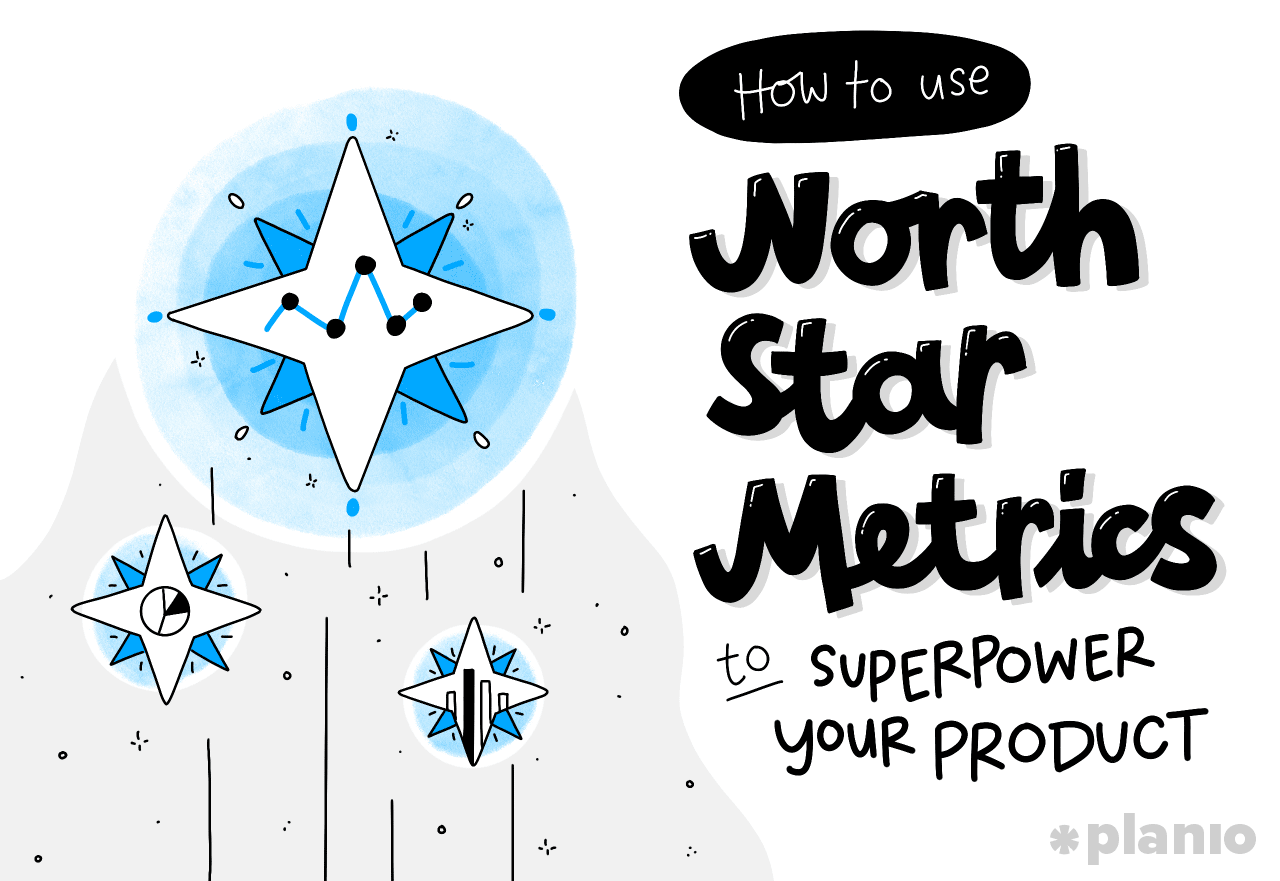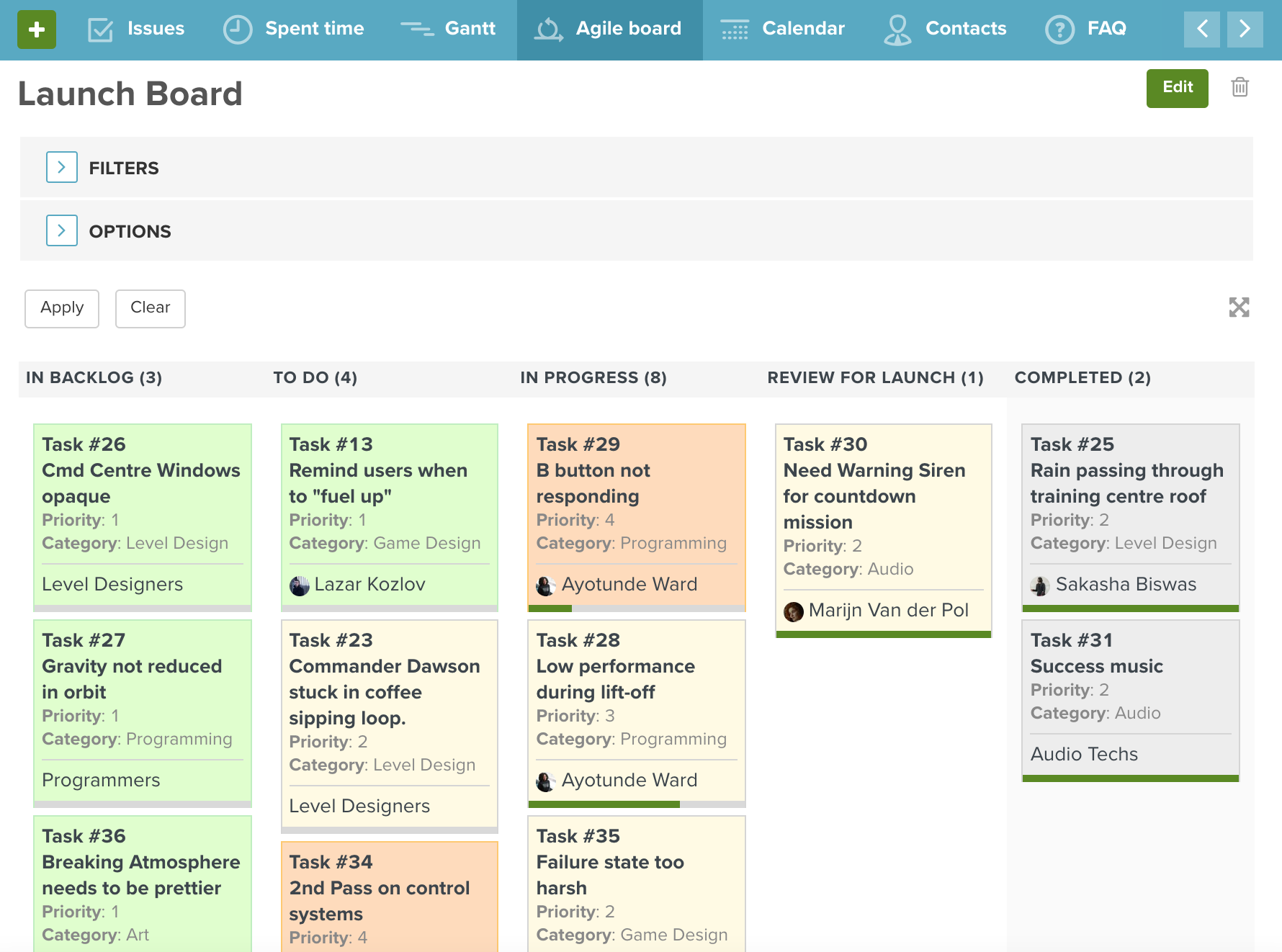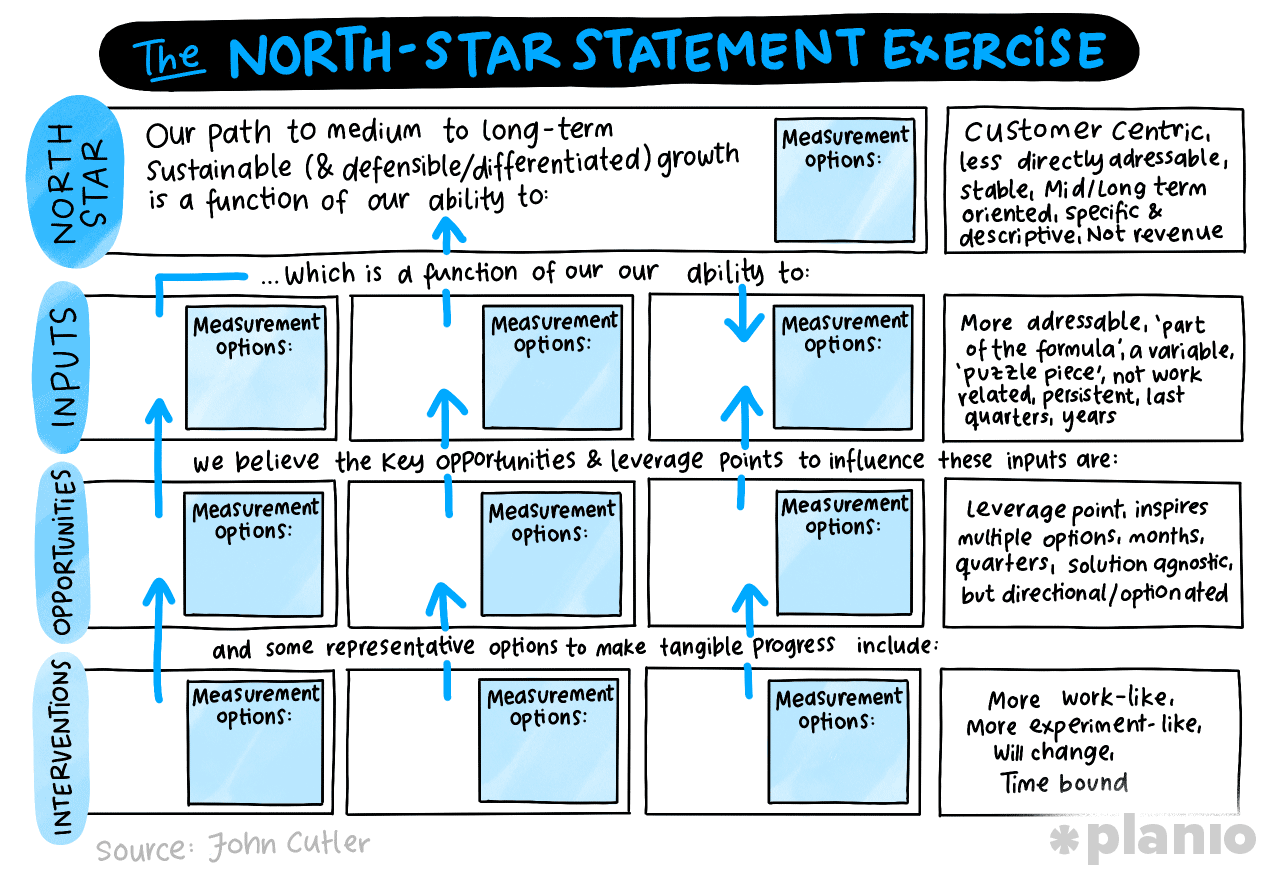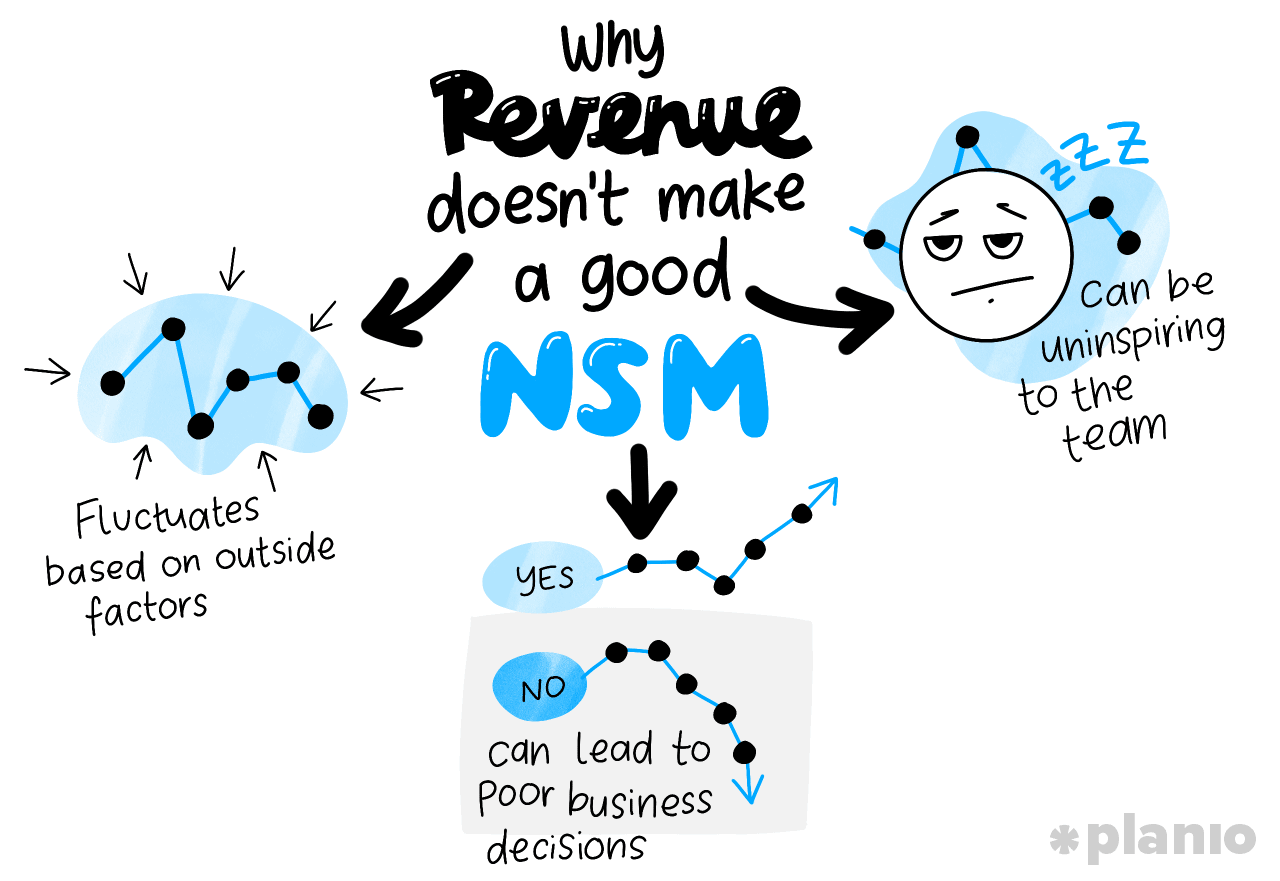How to use North Star metrics to superpower your product

As any project manager can tell you, metrics and data can be overwhelming. Between product data, KPIs, performance metrics, and user research, there are a lot of numbers to review, analyze, and manage on a regular basis.
Choosing one overarching metric — a North Star Metric (NSM) — can separate the signal from the noise. But it can also be dangerous.
Focus is a powerful tool when it’s placed on the right thing. However, if you choose the wrong NSM you could be wasting your time, energy, and money.
Metrics are often how you measure success. (Or at least how you report the success of a project to stakeholders.) Choosing the right ones, and knowing why they’re important, helps set you up for success.
In this guide, we’ll cover the essential elements of understanding, choosing, tracking, and reporting on your North Star Metrics.
What are North Star Metrics?
A North Star Metric is the source of truth that shows your business is meeting the expectations of both your customers and your executives. The right NSM is an essential part of your product strategy as it defines the relationship between the painpoints your product solves and sustainable, long-term business growth.
To be a “North Star”, the metric must:
- Result in revenue
- Reflect customer value
- Evaluate progress
But that’s not all. Focusing on your NSM should, in turn, boost other key business metrics like customer retention and subscription revenue. It’s the one thing that if it grows, your business will too.
This isn’t to say that you should only focus on a single metric and forget the rest.
Depending on your business and product road map, you might have multiple North Stars to follow. And each one will potentially have other sub-metrics and leading indicators that tell you you’re on the right path.
The goal of a North Star Metric isn’t to replace all of your data and reports. It’s to give everyone a direction to aim their efforts towards.
Why use a North Star Metric? 3 reasons why NSMs matter
People use North Star Metrics to get teams, stakeholders, and clients all on the same page.
With so much data, measuring real progress can quickly get complicated. When your team’s focus on different data points, they end up chasing different goals. And when teams set different goals they often end up working against each other instead of collaborating.
The idea behind the North Star Metrics is to align team members, simplify meetings, lower time spent on administration, and help businesses focus on sustainable growth.
Here are three of the main reasons why North Star Metrics are essential to your growth and success:
1. North Star Metrics align business and customer success
A North Star Metric gives the whole company a central goal to focus on.
Instead of getting lost in team-specific goals (like customer success, sales, or technical goals), everyone needs to be able to answer: How does our work impact the North Star Metric?
If they can’t answer it, they need a new goal.
2. Gives you company-wide focus
There’s always lots you could focus on. Usually, the problem is prioritizing what’s most important now. A NSM gives your entire company a clear direction to place their focus. And that’s a powerful tool.
Think back to when you were a kid and you learned how to ride a bike. You were probably taught that where your eyes go, your bike goes. Point your gaze left, you go left. Look right, you go right.
The same goes for your business and product. Where you end up depends on where you place your attention.
3. Provides transparency about what’s important
A North Star Metric also gives everyone clarity about how the business is doing overall. It can help your team see the bigger picture as opposed to getting stuck in the smaller details.
Transparency is critical to your success. Teams need to know how their work impacts the company’s goals in order to set better project objectives and follow OKRs. And the more they can connect what they do to a North Star Metric’s growth, the more motivated they’ll be to work.
Pro tip: A project management tool like Planio provides clarity and transparency across all your projects and teams. Planio’s Agile boards show the status and priority of every current task, so you can quickly dig in and see how all your work is contributing to your North Star Metric.

How to choose the perfect North Star Metric for your business
Sometimes choosing a North Star Metric is easy. You know exactly what you need to do to grow your business and keep your customers happy. But other times it’s more complicated.
Maybe there are multiple directions you could go in. Or you’re unsure which metric will really push you forward. You might need to test projects aligned around different goals to see which ones move the needle how you want.
If you’re just starting out and want to choose the right NSM for your business, follow these steps:
1. Start by choosing the NSM category that best suits your business
Different types of businesses can benefit from using different categories of North Star Metrics.
While North Star Metrics all share similar aims of growing revenue and boosting customer success, zooming in on different categories can help your business focus even more closely on its ultimate targets.
Depending on your business structure, type, and industry vertical, you’ll want to choose one of six categories of North Star Metrics:
1. Revenue: The amount of money generated.
- Metrics: MRR (monthly recurring revenue), GMV (Gross Merchandise Value).
- Best for: B2B SaaS, Ecommerce.
2. Customer growth: The number of users who are paying for the product or service.
- Metrics: Paid users, and market share.
- Best for: Fintech, ecommerce, B2B SaaS.
3. Consumption growth: The level of usage of your product/service beyond users just visiting your website.
- Metrics: Sign-ups, number of customers completing their first order, messages sent.
- Best for: Media, consumer tech, B2B SaaS, ecommerce.
4. Engagement growth: The number of users who are active within the product/service.
- Metrics: Daily active users, monthly active users, total read time, total watch time.
- Bset for: Media, Fintech, B2B SaaS, consumer tech.
5. Growth efficiency: The rate at which you spend vs. make money.
- Metrics: LTV (customer lifetime value), CAC (customer acquisition cost).
- Best for: B2B SaaS, ecommerce, consumer tech.
6. User experience: How easy to use and enjoyable users find the experience of using the product or service.
- Metrics: Customer service satisfaction surveys like NPS.
- Best for: Any.
Pinpointing your North Star Metrics according to the above categories and your industry will help you closely focus on your wider business goals.
A North Star Metric gives the whole company a central goal to focus on.
2. Prioritize your most important business metrics
With a broad category in mind, it’s time to dig into what’s truly essential for the success of your business.
Of course, revenue and subscriptions are critical (no business can survive forever without making money). However, you want to go deeper here and think of the key pillars that need to exist in order for your business to stay above water.
These pillars might include solving a customer problem, generating more sales, and measuring overall progress.
Any North Star Metric needs to consider the interaction of these pillars. For example, a metric that generates sales but doesn’t solve customer problems or measure overall company progress will ultimately fail.
Ask yourself three questions as you work out your key business metrics:
- What is essential to the business’s functioning? Prioritize a list of what actions are most important to your success.
- What KPIs and metrics measure the top few key factors? How do you measure those actions?
- What metric encapsulates all of the above? Does a single metric float to the top of your list or impact the majority of them?
As you go through these steps, you should naturally start to form a metric hierarchy. Your potential North Star will be at the top with each sub-metric feeding into it.
3. Use the JTBD framework to understand what your customers want
North Star Metrics aren’t just business metrics. You also need to consider if they’re representing your customer’s success.
The jobs-to-be-done (JTBD) framework originally created by Clayton Christensen, helps you recognize the problems your customer wants to solve with your product. This goes beyond just ‘knowing your customer’ or something similarly vague.
Instead, ask yourself what task is someone ‘hiring’ our product to solve?
For example, people aren’t buying a hammer to hit a nail. They’re buying it to hang a family photo or build a home.
What are the benefits and use cases for your product? What metrics are the leading indicators that your customers are successful in reaching them?
4. If you’re still stuck, try John Cutler’s North Star Statement exercise
Product developer John Cutler developed a template and accompanying exercise to help teams nail down their North Star more easily.
The idea is to use minimal words and be ultra-clear about growth aims and means of getting there.
You start at the top with what you need to do to meet yout sustainable growth needs and how you might measure that. Then, work downwards and fill in what you need to do in order to reach that goal, what you believe will influence those goals, and other options for making progress.

This is a great way of making abstract and often complex topics clear and more tangible for all team members and managers.
Pro tip: Keep your North Star Metric Statement somewhere public like a Planio Wiki. This way, everyone across your company has quick access to key metrics and why they matter.
5. Doublecheck your North Star by asking these 8 questions
Choosing your company’s North Star metric has major implications and you want to be sure you’re right (or as close to it as possible) before going ahead.
Before you roll out this new NSM across your team, ask these 8 questions:
- When do customers reach the end-result? Your NSM should be near the moment your customer gets the required result from your product or service. For example, at Uber, that’s when a ride gets successfully booked.
- Does this metric apply to all customers? Your NSM should provide value to all customers. A good NSM enables you to focus on customer satisfaction and not just metrics like the number of customer subscriptions or orders.
- Is this moment measurable for us? Customer satisfaction or product success can seem intangible. But what you could measure is items like how frequently customers make repeat purchases or renew their subscription. These metrics would be an indicator of whether customers are satisfied.
- What’s the best frequency? (Day, week, month) Your NSM should be time-bound. You need to see your progress over time and not just an overall metric from the beginning of time.
- Do external factors have a minimum impact? Your NSM shouldn’t be influenced by external factors other than your customers (like ad spend or partnerships). For example, the number of subscription renewals in a three-month period is an NSM that’s between your customers and business.
- Is the NSM growth tied to business growth? If your NSM grows, then your business must grow too. It shouldn’t ever be a false or inflated figure.
- Can everyone at your company impact the metric? A good NSM is something that everyone in the business can influence, no matter their position or team.
- Does my NSM change frequently? Your NSM should stay consistent but remain adaptive to regular feedback. In the best case, your NSM grows every day or week. For that to happen it needs to be tied to a customer action that’s performed regularly.
North Star Metric examples from the world’s biggest companies
North Star Metrics have been the source of massive success and failure for companies and products. As you choose your own, it can help to see how other companies have used North Star Metrics to fuel their own growth and build a loyal and satisfied customer base.
Here are a few examples of well-known businesses that have chosen North Star Metrics to help them guide team members and achieve their goals.
What is Amazon’s North Star Metric?
North Star Metric: Amazon is a complex business with multiple offers and products, so they wouldn’t benefit from having a solo NSM. Instead, let’s look at one of their key offerings: Amazon Prime.
For Prime, Amazon uses ‘number of active prime subscribers’ as their North Star Metric. Their definition of active could be broken down into a specific number of purchases and activities within a given time period.
Why does this work?
Since Amazon Prime is an established product and connects to Amazon’s core business, new member growth isn’t their most important metrict. Instead, their success is dependent on subscribers being engaged with the service by ordering exclusive items, watching video content, and renewing their subscriptions.
What is AirBnb’s North Star Metric?
North Star Metric: Nights booked (consumption growth).
Why does this work?
Marketplace platforms like AirBnb get a cut of every transaction, so it makes sense for them to focus their NSM on the volume of transactions like the number of nights booked. However, nights booked also connects both the success of their users (hosts and guests) and the business.
The more nights you book, the more money everyone makes and the better experience the guests are having.
What is LinkedIn’s North Star Metric?
North Star Metric: Monthly Active Users (consumption growth).
Social media sites have a hard time defining North Star Metrics as they provide so many different services to their users. For LinkedIn, they first decided to focus on one factor that differentiates them from the competition: professional endorsements.
However, it soon became apparent that endorsements were often falsified and didn’t actually improve customer satisfaction. After they were acquired by Microsoft, they switched to a more common NSM: monthly active users.
Why does this work?
Sites like Facebook, Twitter, YouTube, and others make money based on the time you spend engaging with them. By focusing on monthly or daily active users (MAU or DAU), LinkedIn can see if users are satisfied overall with their platform. If it drops, they can dig into sub-metrics that will pinpoint the exact issue.
What is Netflix’s North Star Metric?
North Star Metric: Median view hours per month (Engagement growth optimizing for depth of engagement).
Netflix’s NSM is watch time and centers on the depth of engagement. As an entertainment streaming platform, it’s not enough that users simply check in daily or weekly –– Netflix is looking to increase the level of engagement. They want users to spend as much time as possible watching their content.
Why does this work?
Netflix’s revenue comes from subscriptions so it makes sense that they want users to be engaged in the content and stay around for longer. Plus, the more people view, the better an experience they’re having. Also, a drop off in monthly viewing is a leading indicator that customers could leave.
Why revenue doesn’t make a good NSM
At this point, you might be wondering why more companies don’t just use revenue as their North Star Metric. Doesn’t it only make sense that you want to focus on making money and growing your company?
The truth is that using revenue as your NSM can cause you to focus on the wrong thing. Or, choose short-term gains over long-term success.
Revenue is the money your customer’s give you. But your NSM should reflect the value they get from your product or service. Because in the end, if your customers don’t get value, they’ll leave.
Other than just being the wrong focus, there are three more reasons why you shouldn’t use revenue as your NSM:

- Revenue fluctuates based on outside factors. Revenue can be influenced by external factors like currency exchange rates, seasonal demand, and supply chain changes. Revenue might not always reflect overall company growth and progress or customer satisfaction.
- Concentrating on revenue can lead to poor business decisions. You might be afraid to lower your pricing or give your customers special offers, which can impact your long-term growth.
- Revenue metrics can be uninspiring to the team. People want to feel that they’re contributing and there’s real value to their work. Generating revenue can seem uninspiring to many people, but a number of satisfied customers can seem more interesting since it’s presumed they find value in the product.
Revenue doesn’t make a good North Star Metric.
North Star Metrics are a guide, not a map
In any growing business it’s essential to monitor data and metrics. After all, how are you meant to make evidence-based decisions without them?
But don’t forget to listen to your customers and what they need from your product. There’s no point in blindly following a metric if you see signs that it’s taking you in the wrong direction.
North Star Metrics strike the right balance between following the data and meeting your customers’ needs. And now you have everything you need to find the NSM that’s right for you.


